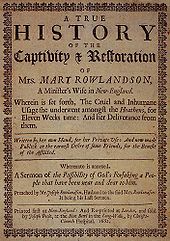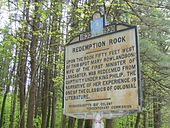- Mary Rowlandson
-
Mary (White) Rowlandson 
Mary Rowlandson from A Narrative of the Captivity, Sufferings and Removes of Mrs. Mary Rowlandson, Boston: Nathaniel Coverly, 1770Born c. 1637
Somersetshire, EnglandDied c. 1711
Massachusetts Bay ColonyOccupation American colonist Spouse Joseph Rowlandson, Captain Samuel Talcott Children Mary, Joseph, Mary, Sarah Mary (White) Rowlandson (c. 1637 – January 1711) was a colonial American woman who was captured by Native Americans[1][2] during King Philip's War and endured 11 weeks of captivity before being ransomed. After her release, she wrote a book about her experience, The Sovereignty and Goodness of God: Being a Narrative of the Captivity and Restoration of Mrs. Mary Rowlandson, which is considered a seminal work in the American literary genre of captivity narratives.
Contents
Biography
Mary White was born c. 1637 in Somersetshire, England, to John and Joan West White of South Petherton as the fifth of eight children. The family left England sometime before 1650, settled at Salem in the Massachusetts Bay Colony and moved in 1653 to Lancaster, on the Massachusetts frontier. There, she married Reverend Joseph Rowlandson, the son of Thomas Rowlandson of Ipswich, Connecticut, in 1656. Four children were born to the couple between 1658 and 1669, with their first daughter dying young.[3]
At sunrise on February 10, 1675,[4] during King Philip's War, Lancaster came under attack by Narragansett, Wampanoag and Nashaway/Nipmuc Indians. Rowlandson and her three children, Joseph, Mary and Sarah, were among the hostages taken. For more than 11 weeks and five days,[5] she and her children were forced to accompany the Indians as they fled through the wilderness to elude the colonial militia.[note 1] She later recounted how severe the conditions during her time of captivity were for all parties. On May 2, 1675, Rowlandson was ransomed for £20 raised by the women of Boston in a public subscription, and paid by John Hoar of Concord at Redemption Rock in Princeton, Massachusetts.
In 1677, Reverend Rowlandson moved his family to Wethersfield, Connecticut, where he was installed as pastor in April of that year. He died in Wethersfield in November 1678. Church officials granted his widow a pension of £30 per year. Mary Rowlandson and her children moved to Boston where she wrote her captivity narrative. It was published in Cambridge, Massachusetts, in 1682, and in London the same year. Scholars used to assume that Rowlandson had died before her narrative was published (Vaughn, 32), but in fact she lived for many more years. On 6 August 1679, she married Captain Samuel Talcott, taking his surname.[6] She eventually died on 5 January 1711, outliving her spouse by just over 18 years.[6]
The Sovereignty and Goodness of God
After her return, Rowlandson wrote a narrative of her captivity recounting the stages of her odyssey in twenty distinct "Removes" or journeys. During the attack on Lancaster, she witnessed the murder of friends and family, some stripped naked and disemboweled. Upon her capture, she travelled with her youngest child Sarah, suffering starvation and depression en route to an Indian village. Sarah, aged 6 years and 5 months, died shortly after arriving in the village. Mary and her other surviving child were kept separately and sold as property, until she was finally reunited with her husband. During her captivity, Rowlandson sought her guidance from the Bible; the text of her narrative is replete with verses and references describing conditions similar to her own.
Rowlandson's book became one of the era's best-sellers, going through four editions in one year. The tensions between colonists and Native Americans, particularly in the aftermath of King Philip's War, were a source of anxiety. People feared losing their connection to their own society. They had great curiosity about the experience of one who had been "over the line", as a captive of American Indians, and returned to colonial society. Many literate English people were already familiar with captivity narratives by British sailors and others taken captive at sea off North Africa and in the Middle East.[7]
Her book earned Rowlandson an important place in the history of American literature. A Narrative of the Captivity and Restoration of Mrs. Mary Rowlandson is a frequently cited example of a captivity narrative, an important American literary genre used by James Fenimore Cooper, Ann Bleecker, John Williams, and James Seaver. Because of Rowlandson's close encounter with her Indian captors, her book is interesting for its treatment of cultural contact. Finally, in its use of autobiography, Biblical typology, and homage to the "Jeremiad", Rowlandson's book helps the reader understand the Puritan mind.
See also
- Monoco, Nashaway sachem
- John Williams (Reverend), who wrote a captivity narrative after being captured in the 1702 Raid on Deerfield
References
- Notes
- ^ Part of the territory is now within Mount Grace State Forest.
- Footnotes
- Works cited
- Colley, Linda (2003), Captives: Britain, Empire, and the World, 1600-1850, New York: Pantheon Books
- Derounian-Stodola, Kathryn Zabelle (1998), Women's Indian Captivity Narratives, Penguin Classics Series, ISBN 0-14-043671-5
- Derounian-Stodola, Kathryn Zabelle and James Arthur Levernier (1993), The Indian Captivity Narrative, 1550-1900, New York: Twayne Publishers, ISBN 0-8057-7533-1
- Neubauer, Paul (January 2001), "Indian Captivity in American Children's Literature: A Pre-Civil War Set of Stereotypes", The Lion and the Unicorn 25 (1)
- Rowlandson, Mary; Salisbury, Neal (ed.) (1997), The Sovereignty and Goodness of God, Boston: Bedford-St. Martin’s, ISBN 0-312-11151-7
- Vaughn, Alden T. and Edward W. Clark, (eds.) (1981), Puritans Among the Indians: Accounts of Captivity and Redemption 1676-1724, Cambridge, Massachusetts, and London, England: Belknap
- Waldrup, Carole Chandler (1999), Colonial Women: 23 Europeans Who Helped Build a Nation, Jefferson, NC: McFarland, ISBN 0-7864-0664-X
- Bibliography
- Lepore, Jill (1998), The Name of War: King Phiip's War and the Origins of American Identity, New York: Alfred A. Knopf
- McMichael, George (ed.) (1989), Anthology of American Literature, 1, New York: Macmillan, ISBN 0-02-379621-9
- Philbrick, Nathaniel (2006), Mayflower: A Story of Courage, Community, and War, New York: Viking Penguin, ISBN 0-670-03760-5
External links
- Works by Mary White Rowlandson at Project Gutenberg (plain text and related formats)
- Works by Mary White Rowlandson at Internet Archive (scanned books digitized facsimile formats)
- A Narrative of the Captivity and Restoration of Mrs. Mary Rowlandson, audiobook by LibriVox
- Mary White Rowlandson, Women's History, About.com
Categories:- 1630s births
- 1710 deaths
- Captives of Native Americans
- Authors of captivity narratives
- Women in 17th-century warfare
Wikimedia Foundation. 2010.



